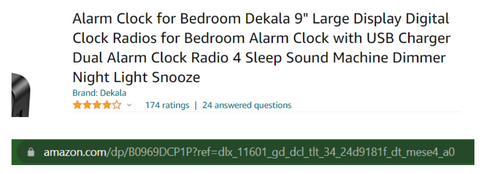10 Tips for Writing Well-Optimized Amazon Titles
What’s in a name—or rather, an Amazon listing title? When it comes to SEO-oriented Amazon product title optimization, saying that “a rose is a rose” is just plain wrong.
That’s because your Amazon title is much more than your Amazon product name in a search result. It can be, or contain, any combination of these things:
- The set of keywords that get your listing to appear on page 1 of a SERP
- A description of the product
- A statement of features or benefits
- A list of potential uses
- A small branding statement
- And more!
So how do you tackle Amazon product title optimization that gets your product in front of shoppers’ eyes, and convinces them to click into your listing? Today we’ll talk about 10 steps for how to optimize Amazon listing titles like the pros!
1. Know the Amazon Title Guidelines
Before doing anything else, go to Amazon Seller Central and review the Amazon title requirements for your product category. You might be confused by some of these—didn’t that brand do this? Didn’t that other brand violate these terms? It’s true that brands often break the rules and don’t adhere to the given Amazon title formula, but doing so is risky.
The brand shown below is playing with fire. If and when their listing gets flagged by a bot, Amazon employee, competing seller, or shopper, the listing could be suppressed or suspended. What’s wrong? Boastful statements such as “best” aren’t allowed.
Any sort of bold medical claim like “heals,” or “improves” needs to be approved by the FDA or the comparable government agency in each country. They’ve gotten away with it for now, but that could change at any moment. Be sure SEO title contains allowed words, so you avoid costly suspensions and missed selling opportunities.
2. Have Quality Keywords
Use a tool such as Ubersuggest, Helium10, or Zonguru to get an idea of what words and phrases people are searching to find products like yours. Build a list of about 30 words and phrases to work with. Avoid awkward phrases that won’t work in a sentence when possible.
Amazon keyword research for Amazon product title optimization is a profoundly technical and nuanced field—don’t overthink it. Having a handful of confirmed keywords that get searched a lot is far better than writing blindly.
Aim for 5-10 keywords in your title. Don’t worry about cramming more in there—keyword stuffing is not a path to success. Keep this as a guiding Amazon search term limit to ensure you're keeping things readable and customer-centric.
Check out this blog for some relevant Amazon keyword tips or get our help if you'd prefer to let the experts lend a hand!

3. Prioritize Information

Don’t be surprised if you can’t fit all the information about a product into the title. It’s a limited space, so some sacrifices must be made. To make these sacrifices easier, make lists detailing:
- Your product’s top 5 most important features
- Your product’s top 5 potential uses or benefits
- Your product’s set pieces with all material details
Don’t be afraid to cut things out of the title, or allude to them with a classic “and more” statement like the one on this garden seeds pack.

4. Brand Name: First or Last?

Amazon recommends putting brand names at the start of titles, but you don’t want to take their word for it. If there’s buzz around your product or brand, such that people search your brand name specifically, you should put your brand name upfront. If you don’t have that kind of name recognition yet, putting your brand name upfront will diminish the value of your canonical URL!
Teton Sports, the brand responsible for the title below, is well-known in the camping and hiking community. Their sales and ratings are strong, and if you check out their Instagram, you’ll see they have a supportive community around them. People search for their name specifically, so it makes sense for their brand name to be upfront.

The brand Naturehike makes a similar product but doesn’t have the established reputation, social media community, or name recognition of Teton (plus their title is too short!). They might be able to build more effectively by putting their brand name at the end and leading with high-value keywords instead.

5. Leverage Your Available Space
For most categories, the Amazon title character limit is 200. You’ll want to be sure to check the specific requirements of your product categories. Never go over the limit, as this can cause your listing to be suppressed, or worse, suspended.
So should you always aim to maximize your entire Amazon product title character limit? Yes, in most cases, you’ll want to use all the space available to you to maximize the number of keywords and product information in the title.
You’ll notice some very successful products have short titles, and this is also what Amazon advises. However, it may not always be an ideal Amazon title length strategy for less known or newly launching companies. If you elect to write a shorter title than what you’re allowed, be sure that you’re gaining more than you’re losing.

This title is only 92 characters long. Apple doesn’t need the extra keyword SEO, but you probably do.

Writing titles is a lot like putting together a puzzle. And just like with puzzles, sometimes it helps to put together your borders first. The next 2 steps describe this process.
6. Draft Your Canonical URL Clause (The First Clause)

What is a canonical URL clause? We won’t get into the technical details, but take our word for it that a nice tidy canonical URL is good for your SEO in Amazon, and other places, too. You can find out more about them on this blog.
In the Amazon product title example below, AmazonBasics has triggered a canonical URL with a simple comma after the word “paper.”


Just look at how nice and clean that looks! Marvel at how the URL actually describes the product! Envy how this link won’t take half a page to copy and paste on a social media post!
To achieve a canonical URL on Amazon, do the following:
- Try to describe your product in exactly 5 or 6 words, using as many keywords as possible. Note that prepositions and connector words are allowed and they don’t count towards the total! Don’t worry if 1 or 2 of the words aren’t keywords.
- Offset this chunk of text with some sort of organizational marking. We prefer and recommend the en dash, though commas and pipes can also work. This separation helps Amazon’s algorithms understand what part of the title should be in the canonical URL. Otherwise, it’s just guessing.
- Aim for between 20 and 40 characters.
Here’s an example:
Marketing Blog About Amazon Title SEO –
Let’s imagine that our keyword phrases are “marketing blog” and “amazon title SEO.” Together these add up to 5 words. The preposition “about” can be used here but doesn’t count against the word limit. If this blog was an Amazon product, the URL would come out looking something like:
https://www.amazon.com/Marketing-Blog-Amazon-Title-SEO/dp/B012345678
We’ll finish writing this title in just a bit. But first…
7. Draft a Title Stinger (The Last Clause)

This is an easy one! Pick a keyword that describes, in broad terms, one of the following:
- The product or product class
- The product category that your brand focuses on
- Some critical element of your branding
Take that keyword, and make it part of a phrase that goes something like:
“Watercolor Pencils by Neato Art Supplies”
Aim for between 20 and 40 characters.
8. Fill In the Puzzle (The Middle Clauses)

- String your canonical clause and branded title stinger together, and separate them with some sort of clear formatting mark. We prefer and recommend en dashes for a variety of reasons.
- Check your total Amazon product title length in characters thus far. This will give you a rough estimate about how much more stuff you can fit in the title.
- Check your keyword content thus far; how many keywords or keyword phrases have you used?
- *Remember the visual reference above? You’re only going to be able to fit 1 or 2 more sentences (aka clauses) worth of text.
- Start playing with words. Keep your keywords in mind, separate clauses with en dashes, and try to express the most important characteristics or benefits of your product.
- Push higher priority things up in the title; this makes it more likely they’ll appear on Amazon mobile, where titles are generally truncated.
- Avoid defaulting to generic feature lists (heavy-duty, stainless steel, slotted, rubber handle, dishwasher safe, blah blah blah); these eat up lots of space very quickly, and aren’t very engaging
- Don’t feel like you need to communicate everything in the title. If this was possible, the rest of your listing would be unnecessary.
As an MxEm-style example, let’s finish the title for our hypothetical Amazon listing for a blog about Amazon listing title SEO. Hypothetical keywords are underlined for reference.
Marketing Blog About Amazon Title SEO – Improve Amazon SEO Optimization for Titles in 10 Steps – DIY Amazon Indexing Secrets for Amazon FBA Sellers – Tips for Selling on Amazon by Marketing by Emma
✅ 198 characters total Amazon product title length
✅ 6 keyword phrases used
✅ Canonical URL Clause
✅ Middle Clauses
✅ Branded Title Stinger Clause
9. Check Your Work and Do a Gut Check

- Make sure all of your clauses are strung together in one well-organized string of text.
- Check your character count.
- Read it out loud a couple of times; it doesn’t need to be poetry, but it does need to be human-readable.
A good example: Nice and tidy, title case, keyword rich but human readable, well within Amazon product title character limits. Notice, also, the tidy canonical URL.


A bad Amazon product title example: Disorganized, keyword stuffed (in a way that can cause suspension), difficult to read, within the Amazon product title character limit but doesn’t leverage space to its maximum potential. Notice that the Amazon bots aren’t sure what keywords belong in the URL, indicating the title is not optimized.

10. Take a Leap of Faith and Come Back Later

Remember that Amazon SEO is as much an art as it is a science. You won’t really know how you did until you publish your listing.
The best way to get an objective sense of how well you’ve optimized your title is to take a step back. Put your draft away for a day or two and then read it again. Or, upload your listing and see how it performs. Tweak little elements of the title from time to time and see what happens.
Once you start appearing on the first page regularly, let the listing run and go about crafting your next one.

Pretty wild how so much thought can go into a simple 200 character bit of text, isn’t it?
But don’t worry—with these 10 basic steps to follow, a little bit of work, and a commitment to experimentation, you can conduct Amazon title optimization that outperforms big-name brands.
Not sure if you’ve hit the mark? Reach out to us for a Free Listing Analysis! Mention this blog and we can focus specifically on your title. Let us give you feedback on your keyword content, structure, phrasing, and canonical URL mechanics.
Just remember that learning how to write Amazon product title copy like a pro takes time and practice. So, if you'd prefer to let an expert take the reins, we'd love to help you figure out how to optimize amazon product listing copy and SEO for success.
Don’t be intimidated by the technical nature of Amazon SEO and Amazon product title best practices. Sit down with these 10 steps and get to work—you’ve got this!

3 comments
How do I insert an en dash into my Amazon listing? Unlike a comma or pipeline, it isn’t a character I can just type (a hyphen is but an en dash isn’t; they’re two different symbols).
Best Amazon Title Guidelines:
Well done! Great work on this topic. I really appreciate your work, the best article i have ever read. Thanks.
Very happy I stumbled across this posting.
Real cogent advice that even I can apply!
Many thanks